

Zen, Buddhism, and the Tao. People search for articles on Buddhist meditation and Buddhism or Zen without knowing what it all means.
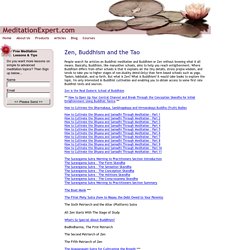
Basically, Buddhism, like manyother schools, aims to help you reach enligthenment. Where Buddhism differs from other schools is that it explains all the tiny details, stress prajna wisdom, and tends to take you to higher stages of non-duality (Mind-Only) than form based schools such as yoga, Taoism, kabbalah, and so forth. But what is Zen? What is Buddhism? It would take books to explore the topic. Zen is the Real Esoteric School of Buddhism *** How to Open Up Your Central Channel and Break Through the Conception Skandha for Initial Enlightenment Using Buddhist Tantra ***
American Buddhist Journal: Search results for zen. After serving as a temple priest in Japan, Suzuki requested to be sent to America, and, in 1959, at the age of 54, he travelled to San Francisco to manage Sokoji, the citys Soto Sect mission.
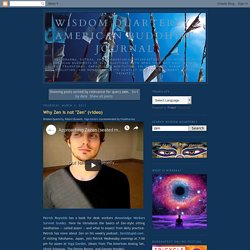
When he arrived, his congregation almost exclusively older Japanese people, although his predecessors had begun to make some efforts at a broader outreach. Suzuki himself proved to be more comfortable teaching Americans than Japanese. He quickly attracted a group which met for regular zazen sittings and lectures in English.
The Tao Te Ching Explained In Depth. The Tao Te Ching, also known as the Dao De Jing, is an ancient attempt to point us toward our true nature written by the Chinese Sage, Lao Tzu, in 6th century B.C.
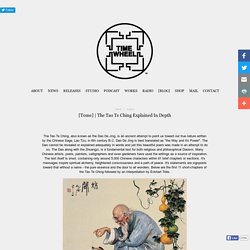
Dao De Jing is best translated as "the Way and it's Power". The Dao cannot be revealed or explained adequately in words and yet this beautiful poem was made in an attempt to do so. Zhuangzi. The Zhuangzi (also known in Wade-Giles romanization romanization as Chuang-tzu), named after “Master Zhuang” was, along with the Laozi, one of the earliest texts to contribute to the philosophy that has come to be known as Daojia, or school of the Way.
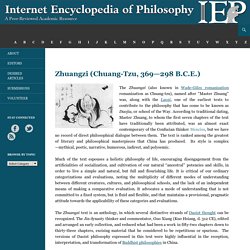
According to traditional dating, Master Zhuang, to whom the first seven chapters of the text have traditionally been attributed, was an almost exact contemporary of the Confucian thinker Mencius, but we have no record of direct philosophical dialogue between them. The text is ranked among the greatest of literary and philosophical masterpieces that China has produced. Its style is complex—mythical, poetic, narrative, humorous, indirect, and polysemic.
Much of the text espouses a holistic philosophy of life, encouraging disengagement from the artificialities of socialization, and cultivation of our natural “ancestral” potencies and skills, in order to live a simple and natural, but full and flourishing life. Table of Contents 1. 2. 3. Laozi (Stanford Encyclopedia of Philosophy) 1.
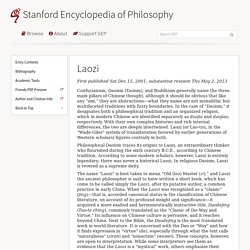
The Laozi Story The Shiji (Records of the Historian) by the Han dynasty (206 B.C.E.–220 C.E.) court scribe and historian Sima Qian (ca. 145–86 B.C.E.) offers a “biography” of Laozi. Its reliability has been questioned, but it provides a point of departure for reconstructing the Laozi story. Laozi was a native of Chu, according to the Shiji, a southern state in the Zhou dynasty (see map and discussion in Loewe and Shaughnessy 1999, 594 and 597). His surname was Li; his given name was Er, and he was also called Dan. “Laozi cultivated Dao and virtue,” as Sima Qian goes on to relate, and “his learning was devoted to self-effacement and not having fame. Few scholars today would subscribe fully to the Shiji report.
In an influential essay, A. The fact that Laozi appears favorably in both Confucian and Daoist sources seems to argue against the likelihood that the figure was fabricated for polemical purposes. How to Consult the I Ching - Divination Foundation. An ancient method for casting an I Ching reading involved a relatively laborious process of sorting fifty stem stalks of the yarrow plant.
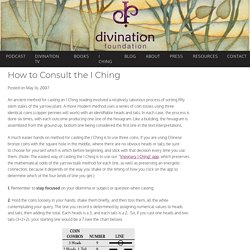
A more modern method uses a series of coin tosses using three identical coins (copper pennies will work) with an identifiable heads and tails. In each case, the process is done six times, with each outcome producing one line of the hexagram. Like a building, the hexagram is assembled from the ground up, bottom line being considered the first line in the text interpretations. A much easier hands-on method for casting the I Ching is to use three coins. If you are using Chinese bronze coins with the square hole in the middle, where there are no obvious heads or tails, be sure to choose for yourself which is which before beginning, and stick with that decision every time you use them. 1. 2. 3.
The hexagram you’ve just created can be called your “present hexagram.” Alternate I Ching Books and References , a modern I Ching scholar from Shanghai. I Ching & the kabbalah – Esoteric Online. Ever since the earliest times, philosophers have been searching for the underlying patterns of order that sustain our world.

These efforts have resulted in a great many systems of symbolic expression purporting to illuminate the various mysteries of reality and life. Careful inspection of these different systems reveals that many of them are based on remarkably similar fundamentals. The numbers of mathematics, for example, have been almost universally regarded as indispensable keys to an understanding of the primary mysteries.
The Tree of Life from the Hebrew Kabbalah and the I Ching of Chinese philosophy are two of the most remarkable systems of analogy based upon numbers. A clear understanding of these systems will provide a powerful calculus whereby all of the complexities of contemporary life may be clearly understood by analogy. We present an arrangement of the Tree of Life which divides it into four parts, corresponding to the Hebrew name of God (Yod-He-Vau-He). The I Ching Connection. Zazen. The Tao.
- Taoism.